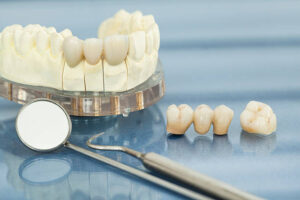A dental crown is an enamel cap that is fitted over a natural tooth. It is tinted to match the colour of your natural teeth. Dental crowns can be used to save teeth, improve your smile, and even assist anchor replacements. Dental crowns aid in the correction of cosmetic bite alignment difficulties, tiny gaps between teeth, malformed or stained teeth, and even minor faults.
Even though only one or two teeth are impacted, a bridge is typically employed. To acquire a bridge, you must have a gap on both sides of your teeth. The molars on both sides are trimmed, and the bridge is constructed with two crowns on each side that are joined to the replacements tooth in the centre.

Dental Crown Advantages
Tooth System Preservation and Recovery: A Crown and Bridges is the greatest approach to safeguard an endangered tooth. Crowns are often required to safeguard teeth that become weak following root canal therapy.
A crown not only provides physical protection but also contributes to the visual appeal. Crowns can aid in the restoration of a tooth’s original form. Ceramic dental crowns are both sturdy and aesthetically pleasing. The crowns’ colour can be matched to that of the adjoining teeth. They can also help you restore or improve your natural smile.
A crown is effectively an artificial tooth. It is frequently made of porcelain or concrete, which can be coloured and textured to match your readily incorporated. When replacing a back tooth, a crown made of gold metals might be used for extra strength. To offer durability and a natural look, porcelain is commonly attached to the outside of a metal crown.
Who Should Have a Dental Crown or Bridge Placed?
If you have destroyed, broken, misaligned, or weakened teeth, a dental crown is the better option. It can also be used to treat tooth decay and headaches. A bridge is recommended for those who have large gaps between their teeth.
Nevertheless, make sure you don’t have any brittle bones since your jawbones should really be robust enough already to handle the thickness of the bridge when it’s inserted. If you have gaps in your molars or are breaking bones, you are most likely suffering from bone degradation. In such circumstances, you should consult a dentist to obtain X-rays of your jaw structure and determine whether you are a good candidate for surgery.
Improved Eating:
Injury to a tooth or the removal of one or more teeth can make chewing harder. When it becomes tough to chew or bite veggies, apples, or meats, you may avoid these nutritious foods, leading to nutritional deficits. A crown, bridge, or dental implant simplifies eating and may even keep you healthy.
Crowns are commonly used to preserve and support sensitive teeth that have become weaker owing to age, fissures, root canal therapy, trauma, or large fillings.
No More Suffering: Broken teeth may be excruciatingly painful. A crown preserves the tooth while also alleviating pain and sensitivity.

Improved Appearance:
Until they have a tooth condition, many people have no understanding of how often they take their smiles for casually. Even little imperfections might make you self-conscious. Crowns and bridges enhance your look and boost your confidence in your smile. Our dentist may propose a crown if you have a discoloured tooth or want to modify the shape or length of a tooth. Bridges and crowns coupled to dental implants fix gaps in your teeth, transforming your smile totally.
Crowns and Bridges Cost are an excellent long-term alternative since they are durable, increasing quality of care with the treatment. When compared to alternative dental rehabilitation approaches or no treatment at all, therapy with dental crowns has a high success rate. Many scientific investigations that investigated their usage have corroborated this. Contact us now!